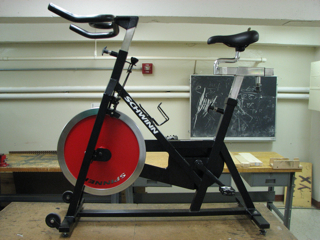Exercise bike
From DDL Wiki
Contents |
Executive Summary
Product Function
Product Use
The product is a stable platform used for cycling practice as well as a smooth, intense workout. The user mounts the bike, sitting on the seat. Feet rest on the pedals and hands on the rubber handles to the front of the bike. While holding the handles, feet on the pedals and sitting on the seat, the rider is provided a stable riding position. To ride, the user pedals forward (backward is not recommended by Schwinn) exerting significant effort to build momentum in the heavy flywheel. Once user reaches a comfortable speed their effort levels to a steady pace. There are a few ways to stop, all not very intuitive to basic bike riders. There is a knob on the frame that can be turned to apply a clamp-brake to the flywheel that will slow the wheel down. The user can also completely remove their legs from the pedal assembly, but this is not recommended since it is dangerous and the momentum in the wheel is too high and will spin for a very long time. The user could also cool down by gradually reducing their pedal speed till it becomes slow enough to dismount. This is recommended anyway in any strenuous workout, stopping abruptly is not good for the body.
Bill of Materials
Insert non-formatted text here
| Part/Sub-assembly | Part # | Part Name | QTY | Weight (g) | Function | Manufacturing Process | Material | Image |
|---|---|---|---|---|---|---|---|---|
| Seat | 1 | Seat | 1 | 428 | Allows user to sit on bike | press fit/lay over cloth and stitch | foam, plastic, stainless steel | |
| - | 2 | bolt | 1 | 25 | Assembles seat to seat support | forging, thread rolling | stainless steel | |
| - | 3 | sm. washers | 2 | 15 | Assembles seat to seat support | stamping | stainless steel | |
| - | 4 | lg. washers | 2 | 15 | Assembles seat to seat support | forging, thread rolling | stainless steel | |
| - | 5 | nuts | 2 | 5 | Assembles seat to seat support | casting thread tapping | stainless steel |
All extra weight on frame =
10271
- We were not able to dissect the wheel sub-assembly due to the high pressure that the assembly is under at all times. Dissecting the wheel would be extremly dangerous, and once it was dissected, getting the wheel under the same high pressure would have requried special tools that we do not have access to. The conclusion that dissection was not a good idea was supported by the expert machinists in the Carnegie Mellon machine shop in Hamerschlag Hall.
- Removing the bike pedals from the bike frame was not a possibility for our group due to the need of a special bike-specific tool called a crank arm extractor. More information can be found by watching this video: http://www.youtube.com/watch?v=H6aHvq4oD9o. In addition, the sprocket is welded to the pedal crank, making it impossible to remove.
Design for Manufacture and Assembly (DFMA)
Design for Manufacture
Abe
Design for Assembly
Casey It became apparent while dissecting the product that the design for assembly of the Schwinn Spinner exercise bike was carefully planned as well as pragmatic. This made the dissection and re-assembly process relatively easy and safe.
In terms of safety the bike is designed so that the heaviest object, the 40 pound wheel, cannot slip out of its supports after any one particular piece is removed. There is at least a second line of defense to support the wheel. If this were not the case, it would be easy for anyone to get hurt or break the bike not knowing which particular piece held the wheel. Once that piece was loosened, the wheel could easily slip and crack another part of the bike or fall on someone’s hand or foot.
It is important to note that the assembly makes it easy to remove pieces which would do not have easy access. For example, the back casing which is sandwiched between the pedal cranks and the bike frame can be slipped out from behind due to its design, which incorporates slots into the axle holes. This allows the user to remove the casing without completely removing everything else from the axles.
Many of the bike parts are sub assemblies themselves which is a great DFA because it creates a layering affect for dissection. In order to replace a small part on the bike there is never a time when the entire bike would need to be taken apart. Instead, the user would remove the particular sub-assembly the part belongs to and then dissect that assembly, keeping the remainder of the bike intact. The design also follows a format of high-quality DFA by minimizing the part count and using larger, welded parts rather than piecing these larger parts together with nuts and bolts. In most cases, the large welded parts like the handlebars and seat assembly have easy attachment and adjustment to the base frame with a pin and slot design.
FMEA
Boss
Design for Environment (DFE)
Abe and Casey
Mechanical Analysis
Shobhit

